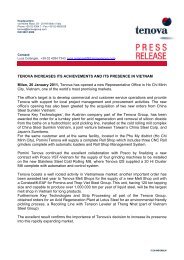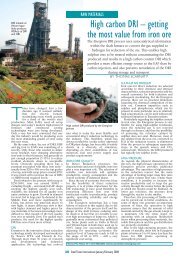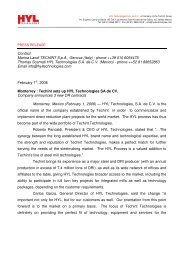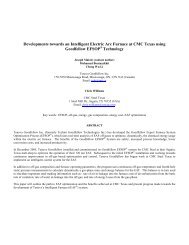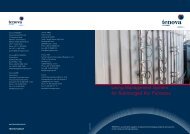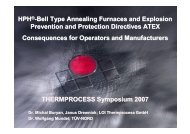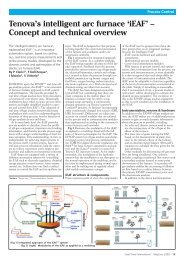Download PDF - Tenova
Download PDF - Tenova
Download PDF - Tenova
You also want an ePaper? Increase the reach of your titles
YUMPU automatically turns print PDFs into web optimized ePapers that Google loves.
MILLENNIUM STEEL INDIA 2008<br />
60<br />
Recent developments in<br />
submerged arc smelting technology<br />
Like all areas of the steel industry, operators of submerged arc smelting plants are requiring<br />
higher productivity, safety and reliability, coupled with reductions in energy and pollution.<br />
<strong>Tenova</strong> Pyromet’s continuous improvement policy provides furnaces with a range of innovations<br />
addressing these requirements.<br />
Authors: Paolo Argenta, Chris Oertel and Bruce Nourse<br />
<strong>Tenova</strong> Pyromet (Pty) Ltd<br />
Submerged Arc Furnace (SAF) technology is<br />
continuously evolving towards the goal of bigger,<br />
safer, cleaner and more effective operations. <strong>Tenova</strong><br />
Pyromet is supplying the industry with furnaces for<br />
ferroalloy smelting, base metal refining, slag cleaning<br />
and waste product treatment. SAFs of up to 80MVA are<br />
designed to each client’s specific requirements, including<br />
accurate, fully automated raw material feed and preheating<br />
systems, Pyromet or Tagliaferri electrode systems,<br />
refractory freeze linings and management systems.<br />
Options for gas cleaning include wet scrubber or bag<br />
house systems as well as flue gas desulphurisation. Gas<br />
cooling is achieved in trombone, water spray or forced<br />
draught coolers. All designs are safety and environmentally<br />
compliant in line with the requirements of local legislation.<br />
Some of the latest developments are described below.<br />
r Fig 1 SAFECOOL® sidewall copper cooling system<br />
SIDEWALL LINING/COOLING SYSTEMS<br />
SAFECOOL® is an ultra-safe sidewall copper cooling<br />
system which has been used in SAFs for both slag<br />
cleaning and primary smelting (see Figure 1). An<br />
example is at Bus Valera in France. The copper cooling<br />
elements penetrate the furnace shell while the cooling<br />
water channels remain external to the furnace shell, thus<br />
providing excellent cooling and safety.<br />
For applications with high heat loads combined with<br />
an aggressive liquid slag bath, a high intensity sidewall<br />
copper cooling system – MAXICOOL® – of the waffle or<br />
stave type was developed (see Figure 2). It consists of<br />
cast copper of a high purity and conductivity with cast-in<br />
monel piping forming the cooling water circuits. A unique<br />
star pattern was designed for the hot face of the coolers<br />
to provide support initially for the monolithic refractory,<br />
and later for the frozen slag layer.<br />
All <strong>Tenova</strong> Pyromet’s sidewall copper cooling systems<br />
are designed to maintain a stable slag freeze lining,<br />
resulting in an increased furnace campaign life.<br />
The first MAXICOOL® system was installed on a<br />
30MVA platinum slag cleaning furnace for Anglo<br />
Platinum in South Africa. Other installations are the slag<br />
smelting furnace at Elkem Solar in Norway, as well as for<br />
the first ever ISACONVERT® furnace in Zambia (under<br />
construction). The Elkem Solar furnace cooling system<br />
makes use of a high temperature oil-based heat<br />
transfer fluid.<br />
SAF CONTROLLER<br />
A new generation furnace controller has been developed<br />
that uses sophisticated control algorithms to achieve<br />
maximum power input into the furnace. By adjusting<br />
electrode and transformer tap positions the controller<br />
optimises the furnace power input. The PC-based<br />
controller uses an OPC to interface with the furnace PLC,<br />
allowing for easy installation on almost any type of PLC<br />
and which can be retrofitted to existing SAF installations.<br />
All operating information is stored in an SQL database<br />
and supports both local and remote connections. The<br />
controller is available for both standard 3 electrode
furnaces (IFM, TATA, US Valera) as well as 6 in-line<br />
electrode SAFs (McMoran Copper & Gold). The latest<br />
system includes a new electrode management algorithm<br />
for Soederberg Electrodes.<br />
LINING MANAGEMENT SYSTEM<br />
A lining management system (LMS) has been developed<br />
for monitoring the furnace lining. It provides the operating<br />
staff with a tool to predict long-term lining life, acts as<br />
a process optimisation tool and alarms and records nonstandard<br />
furnace conditions. It includes vertical and<br />
horizontal furnace sections showing estimated isotherms<br />
through the lining as well as the furnace bath. It also<br />
shows calculated heat flux values, estimated lining wear<br />
and the freeze layer profile. A novel 3D display provides the<br />
operator with a good view of the furnace crucible profile<br />
under real time operating conditions. It also includes a<br />
powerful trending facility for analysing both measured<br />
and calculated values. Since its development, the LMS<br />
has been implemented on FeCr, SiMn and FeSi SAFs, the<br />
ISACONVERT® furnace and on slag cleaning furnaces.<br />
MULTIPLE PRE-HEATER<br />
The newest technology from <strong>Tenova</strong> Pyromet’s<br />
R&D activities is a new generation multiple pre-heater<br />
(MPH) for SAFs, developed together with Outotec. The<br />
purpose of preheating is to eliminate the moisture<br />
from the feed charge mixture and preheat it to<br />
500-600°C. The thermal power in preheating during<br />
normal operation is 10-12MWh/h. Preheating decreases<br />
the electrical energy consumption in the smelting process<br />
by about 10%, but it also increases the CO content of the<br />
SAF off-gas and stabilises the resistance of the burden.<br />
Preheating improves the operation, production and safety<br />
of the smelting. SAF production increases accordingly.<br />
There are three preheating shafts above the furnace,<br />
each connected to three refractory lined charging tubes,<br />
each with an individual feed bin. A rotating belt feeder<br />
distributes the charge material into each of the feed bins.<br />
Level indicators are used to control the material levels in<br />
the MPH shafts and feed bins, then a tube feeder feeds<br />
the material into the MPH from the feed bin.<br />
Furnace top gas is combusted as the heat source. The<br />
burnt gas is cooled by recalculating the MPH top gas<br />
and then fed counter-current into the bottom of the<br />
MPH. The shaft temperature in each MPH is controlled<br />
individually to obtain the correct material discharge<br />
temperature. The material flows by gravity through the<br />
MPH units into the feed tubes, the rate of feed being<br />
controlled by the furnace melting rate. The material in<br />
the feed tubes forms a gas seal between the furnace and<br />
MPH unit. The off-gas is cleaned in a venturi scrubber<br />
before being recycled or discharged to atmosphere.<br />
primary operations<br />
r Fig 2 MAXICOOL® sidewall copper cooling system<br />
The units are located around the top of the SAF electrodes,<br />
significantly reducing the height of the furnace building<br />
and making it conducive for retrofitting to existing SAFs.<br />
This layout also reduces the feed tube length, so decreasing<br />
the heat losses, resulting in higher feed temperatures. The<br />
combustion system is design for large turn down ratios<br />
enabling the MPH to remain on even when the furnace<br />
is operating at its lowest power input. The combustion<br />
system is reactive to furnace gas composition change<br />
which ensures correct combustion and minimal risk of<br />
excess air or CO in the MPH units. Volatiles released in the<br />
units are recirculated to the combustion chamber thereby<br />
reducing tar build-up in the system.<br />
REDUCTION OF WASTE<br />
<strong>Tenova</strong> Pyromet has built both AC and DC furnaces to<br />
treat waste products or tailings streams from metallurgical<br />
and other processes. These furnaces convert a waste<br />
product (such as steel plant dust) into a saleable pig iron<br />
or alloy, and a vitreous slag that can be used as road<br />
fill or a cement additive. The primary driver is usually<br />
the conversion of toxic waste into an inert slag that can<br />
safely be dumped, while the value of the alloy produced<br />
may be secondary.<br />
FURNACE GAS CLEANING<br />
In line with global environmental requirements, gas<br />
cleaning plants to treat the gaseous emissions from SAF<br />
plants are provided. Our third-generation two stage venturi<br />
scrubber design has been developed to clean hot furnace<br />
gas streams containing significant dust loading, with<br />
controls to ensure safe furnace operation. Secondary fumes<br />
from taphole operations can be recovered in specialised<br />
bag filter plants or a low pressure venturi scrubber. a<br />
MILLENNIUM STEEL INDIA 2008<br />
61
MILLENNIUM STEEL INDIA 2008<br />
62<br />
primary operations<br />
CO-GENERATION AND<br />
GREENHOUSE GAS REDUCTION<br />
Process gasses are generated from closed SAFs with<br />
a substantial percentage of carbon monoxide and<br />
hydrogen which are currently flared into the atmosphere<br />
in the form of carbon dioxide, a designated greenhouse<br />
gas under Annex A of the Kyoto Protocol. There exists the<br />
opportunity for the collection of these process gasses for<br />
use as the energy source for the generation of low carbon<br />
electricity for sale into the electricity grid or for on-site<br />
consumption. Co-generation projects for the ferro-alloy<br />
industry can be implemented as Clean Development<br />
Mechanism (CDM) projects within the provisions of<br />
the United Nations Framework Convention on Climate<br />
Change and its attendant Kyoto Protocol.<br />
In China, <strong>Tenova</strong> Pyromet is involved in the supply of two<br />
silicon metal furnaces that will supply hot gas to a heat<br />
recovery steam generator capable of powering a 12MW<br />
steam turbine. In South Africa, we are working closely<br />
with AAP Carbon, an engineering-empowered investment<br />
banking firm with specialist knowledge and experience in<br />
the field of carbon asset management and CDM project<br />
development. As an example, a 2 x 66MVA FeCr furnace<br />
producing 21,000Nm 3 /h of gas (72%CO, 3%H2) has an<br />
annual electricity potential of 150,000MWh.<br />
CONCLUSIONS<br />
The ferroalloy and base metal industry is undergoing<br />
a new era of technological development. Several<br />
technologies are being successfully tested to improve<br />
productivity, safety, energy reduction, pollution<br />
and reliability.<br />
R&D investment, the proper implementation of a<br />
continuous improvement policy and the association with<br />
reliable and technologically advanced partners are the key<br />
actions <strong>Tenova</strong> Pyromet has taken to deliver the results<br />
expected by today’s and tomorrow’s customers. MS<br />
Paolo Argenta, Chris Oertel and Bruce Nourse are all with<br />
<strong>Tenova</strong> Pyromet (Pty) Ltd.<br />
CONTACT: chri.oertel@za.tenovagroup.com<br />
a




